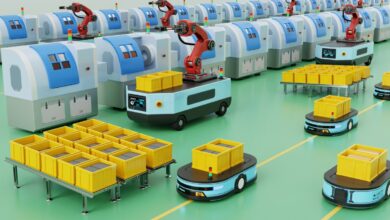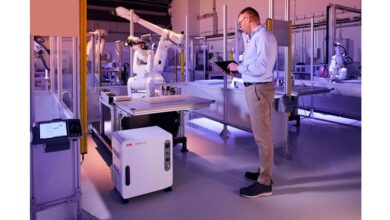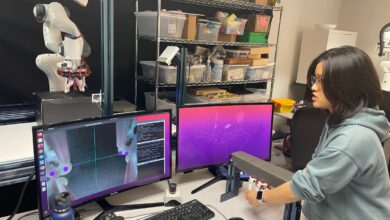Unleashing potential: The role of software development in advancing robotics

|
Listen to this article |

A robotics strategy should consider software development in parallel, says Radixweb. Source: Adobe Stock
In today’s fast-tech era, robotics engineering is transforming multiple industrial sectors. From cartesian robots to robotaxis, cutting-edge technologies are automating applications in logistics, healthcare, finance, and manufacturing. Moreover, automation uses modern software to execute multiple tasks or even one specific task with minimal human interference. Hence, software development is a critical player in building these robots.
The growing technology stack in robotics is one reason the software development market is expected to reach a whopping valuation of $1 billion by 2027. The industry involves designing, building, and maintaining software using complex algorithms, machine learning, and artificial intelligence to make operations more efficient and enable autonomous decision making.
Integrating robotics and software development
With the evolution of robotics, this subset of software engineering offers a new era of opportunities. Developers are now working on intelligent machines that can execute multiple tasks with minimal human intervention. Also, new software frameworks power these systems that are designed for them.
From perception and navigation to object recognition and manipulation, as well as higher-level tasks such as fleet management and human-machine interaction, reliable and explainable software is essential to commercially successful systems.
One of the essential functions software engineering is the building and testing of robotics applications. Hence, developers need to simulate real-world scenarios and accumulate insights for testing goals. The goal is to recognize and rectify bugs before implementing apps in a real environment.
In addition, developers should remember that they are building systems to minimize human effort, not just improve industrial efficiency. Their efforts are not just for the sake of novel technologies but to provide economic and social benefits.
 Submit your presentation idea now.
Submit your presentation idea now.
Software developers can advance robotics
Integrating software and robotics promises a symbiotic partnership between the two domains. Apart from collaborating on cutting-edge systems, coordinated development efforts enable the following benefits:
- Consistency — Robots can be programmed to execute commands with consistency, eradicating human errors caused by distractions or fatigue.
- Precision — Advanced algorithms also allow robots to enhancing overall product quality.
- Increased speed — Software-driven robots can carry out tasks much faster than human beings, saving time and money in production activities.
- Motion planning — Along with modern motors, motion control software allows robots to navigate through complex environments while avoiding potential injuries or collisions.
- Minimal risk — Advanced robots can handle tasks that involve high physical risks, extreme temperatures, or exposure to toxic materials, ensuring employees’ safety.
- Remote operations — Some advanced software for robots enables them to be monitored and controlled remotely, minimizing the need for human workers to be always present in hazardous settings.
- AI and machine learning — The integration of AI can help robots understand, learn, adapt, and make independent decisions based on the data collected.
- Real-time data analysis — As stationary and mobile platforms, robots can gather large amounts of data during their operations. With the right software, this data can easily be examined in real time to determine areas for improvement.
- Scalability — Robot users can use software to scale robot fleets up or down in response to ever-changing business demands, providing operational flexibility.
- Reduced downtime — With predictive maintenance software, robots can reliably function for a long time.
- Decreased labor costs — Robotics minimizes the requirement for manual labor, reducing the cost of hiring human resources and emphasizing more complex activities that need creativity and critical thinking.
Best practices for integrating software and robots
To fully leverage the benefits of software development for robotics, businesses must adopt effective strategies. Here are a few tailored practice to consider:
- Design an intuitive user interface for managing and configuring automated processes.
- Integrate real-time monitoring and reporting functionalities to track the progress of your tasks.
- Adopt continuous integration practices to integrate code modifications and ensure system durability constantly.
- Adhere to applicable data-privacy and cybersecurity protocols to maintain client trust.
- Analyze existing workflows to detect any vulnerabilities and areas for improvement.
- Use error-handling techniques to handle any unforeseen scenarios.
- Implement automated testing frameworks to encourage efficient testing.
- Provide suitable access controls to protect these systems from unauthorized access.
- Identify the applications that can be automated for a particular market.
- Break down complicated tasks into teeny-tiny, manageable steps.
- Perform extensive testing to recognize and rectify any issues or errors.
As robotics finds new use cases, software must evolve so the hardware can satisfy the needs of more industries. For Industry 4.0, software developers are partnering with hardware and service providers to build systems that are easier to build, use, repurpose, and monitor.
Innovative combinations of software and robotics can result in new levels of autonomy and open new opportunities.
 About the author
About the author
Sarrah Pitaliya is vice president of marketing at Radixweb, With a strong hold on market research and end-to-end digital branding strategies, she leads a team focused on corporate rebranding, user experience marketing, and demand generation.
Radixweb is a software development company with offices in the U.S. and India.



